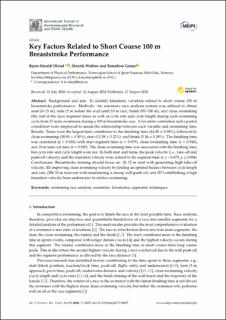Key Factors Related to Short Course 100 m Breaststroke Performance
| dc.contributor.author | Olstad, Bjørn Harald | |
| dc.contributor.author | Wathne, Henrik | |
| dc.contributor.author | Gonjo, Tomohiro | |
| dc.date.accessioned | 2021-02-02T12:06:48Z | |
| dc.date.available | 2021-02-02T12:06:48Z | |
| dc.date.created | 2020-10-02T12:54:08Z | |
| dc.date.issued | 2020 | |
| dc.identifier.citation | International Journal of Environmental Research and Public Health (IJERPH). 2020, 17(17), Artikkel 6257. | en_US |
| dc.identifier.issn | 1661-7827 | |
| dc.identifier.uri | https://hdl.handle.net/11250/2725796 | |
| dc.description | This article is an open access article distributed under the terms and conditions of the Creative Commons Attribution (CC BY) license (http://creativecommons.org/licenses/by/4.0/). | en_US |
| dc.description.abstract | Background and aim: To identify kinematic variables related to short course 100 m breaststroke performance. Methods: An automatic race analysis system was utilized to obtain start (0–15 m), turn (5 m before the wall until 10 m out), finish (95–100 m), and clean swimming (the rest of the race) segment times as well as cycle rate and cycle length during each swimming cycle from 15 male swimmers during a 100 m breaststroke race. A bivariate correlation and a partial correlation were employed to assess the relationship between each variable and swimming time. Results: Turns were the largest time contributor to the finishing time (44.30 ± 0.58%), followed by clean swimming (38.93 ± 0.50%), start (11.39 ± 0.22%), and finish (5.36 ± 0.18%). The finishing time was correlated (p < 0.001) with start segment time (r = 0.979), clean swimming time (r = 0.940), and 10 m turn-out time (r = 0.829). The clean swimming time was associated with the finishing time, but cycle rate and cycle length were not. In both start and turns, the peak velocity (i.e., take-off and push-off velocity) and the transition velocity were related to the segment time (r ≤ −0.673, p ≤ 0.006). Conclusions: Breaststroke training should focus on: (I) 15 m start with generating high take-off velocity, (II) improving clean swimming velocity by finding an optimal balance between cycle length and rate, (III) 10 m turn-out with maintaining a strong wall push-off, and (IV) establishing a high transition velocity from underwater to surface swimming. | en_US |
| dc.language.iso | eng | en_US |
| dc.subject | swimming race analysis | en_US |
| dc.subject | automatic | en_US |
| dc.subject | kinematics | en_US |
| dc.subject | segments | en_US |
| dc.subject | techniques | en_US |
| dc.title | Key Factors Related to Short Course 100 m Breaststroke Performance | en_US |
| dc.type | Peer reviewed | en_US |
| dc.type | Journal article | en_US |
| dc.description.version | publishedVersion | en_US |
| dc.rights.holder | © 2020 by the authors. | en_US |
| dc.source.pagenumber | 16 | en_US |
| dc.source.volume | 17 | en_US |
| dc.source.journal | International Journal of Environmental Research and Public Health (IJERPH) | en_US |
| dc.source.issue | 17 | en_US |
| dc.identifier.doi | 10.3390/ijerph17176257 | |
| dc.identifier.cristin | 1836589 | |
| dc.description.localcode | Institutt for fysisk prestasjonsevne / Department of Physical Performance | en_US |
| cristin.ispublished | true | |
| cristin.fulltext | original | |
| cristin.qualitycode | 1 |
Tilhørende fil(er)
Denne innførselen finnes i følgende samling(er)
-
Artikler / Articles [2096]
-
Publikasjoner fra Cristin [1084]
